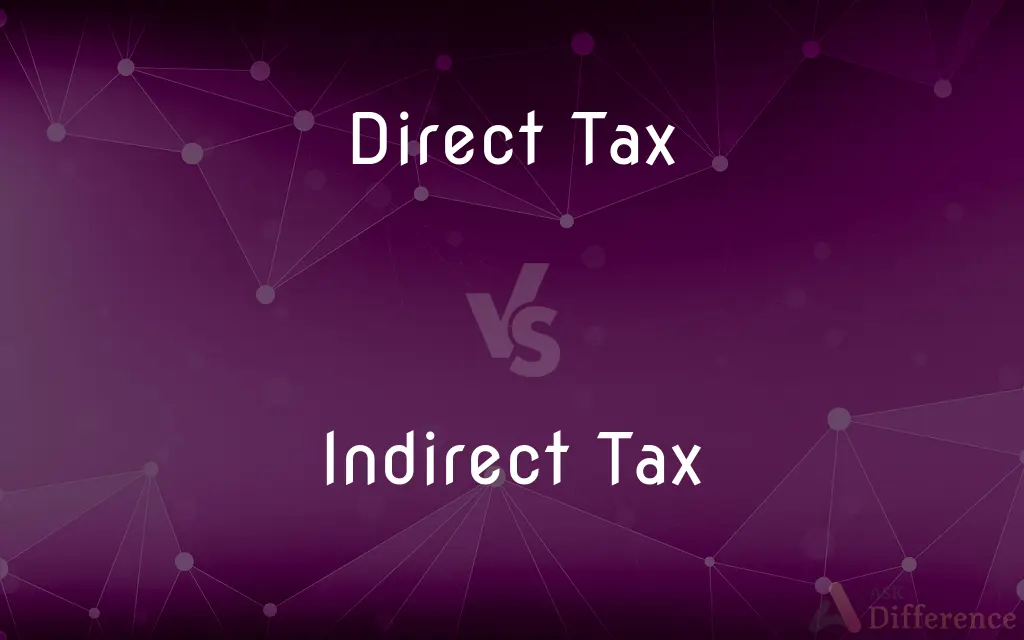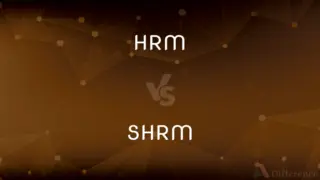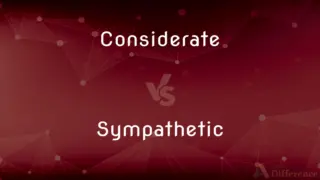Direct Tax vs. Indirect Tax — What's the Difference?
By Tayyaba Rehman — Published on October 6, 2023
Direct Tax is paid directly to authorities by an individual or organization based on income or assets, while Indirect Tax is levied on goods and services, paid indirectly.

Difference Between Direct Tax and Indirect Tax
Table of Contents
ADVERTISEMENT
Key Differences
Direct Tax is levied on individuals or entities based on their income or the value of assets they own. It's a direct obligation of the taxpayer to the government. Conversely, Indirect Tax is applied to the manufacture or sale of goods and services, making it an indirect obligation.
Income tax, wealth tax, and corporate tax are common forms of Direct Tax. These taxes are predictable and are often progressive in nature. On the other side, Indirect Tax includes value-added tax (VAT), sales tax, and excise duty, which consumers pay only when they make a purchase.
Direct Tax has a direct relationship with the taxpayer. It's a straightforward transaction where the taxpayer knows the exact amount they owe. Indirect Tax, however, isn't as apparent. Consumers might be unaware of the precise tax amount since it's typically integrated into the final price.
The principle behind Direct Tax is often the ability to pay. It considers factors like income level and asset value. Meanwhile, Indirect Tax follows the benefit principle, suggesting that those who benefit more from state-provided services should pay more in taxes.
While both Direct Tax and Indirect Tax are essential sources of revenue for governments, their impacts and applications differ significantly. Direct Tax aims at wealth distribution, while Indirect Tax focuses on consumption patterns.
ADVERTISEMENT
Comparison Chart
Definition
Tax on income or asset value.
Tax on goods and services.
Paid by
Individuals or entities directly to the government.
Consumers indirectly when purchasing goods or services.
Examples
Income tax, corporate tax.
Sales tax, VAT, excise duty.
Basis of Taxation
Ability to pay.
Consumption or usage.
Visibility to Taxpayer
Direct and clear.
Often integrated into the price; less visible.
Compare with Definitions
Direct Tax
Aims at wealth redistribution.
Through Direct Tax, wealthier individuals contribute more to the state's revenue.
Indirect Tax
Passed down to consumers in product pricing.
The manufacturer includes the Indirect Tax in the final product's cost.
Direct Tax
Tax levied on personal or corporate income.
The company must pay a Direct Tax on its annual earnings.
Indirect Tax
Often regressive in nature.
Everyone pays the same Indirect Tax rate, regardless of income.
Direct Tax
Often progressive in nature.
As my salary increased, my Direct Tax liability also went up.
Indirect Tax
Levied at the point of sale or production.
An Indirect Tax is added when the item is sold to the end consumer.
Direct Tax
Obligation paid straight to the government.
I file my Direct Tax returns every April.
Indirect Tax
Affects consumption patterns.
Raising the Indirect Tax might reduce the demand for certain luxury goods.
Direct Tax
Based on one's ability to pay.
Higher income brackets might have higher Direct Tax rates.
Indirect Tax
Tax imposed on goods and services.
The price includes an Indirect Tax that goes to the state.
Common Curiosities
What is Direct Tax?
Direct Tax is a tax levied on an individual's income or an entity's earnings, paid directly to the government.
Why might a government increase Indirect Taxes?
To control consumption or generate revenue without directly taxing incomes.
How is Indirect Tax different from Direct Tax?
Indirect Tax is levied on goods and services, paid indirectly by consumers upon purchase.
Which tax is more predictable, Direct or Indirect?
Direct Tax is generally more predictable since it's based on income or asset value.
Are property taxes considered Direct Tax?
Yes, property taxes are a form of Direct Tax based on asset value.
Which tax is progressive, Direct or Indirect?
Direct Tax is often progressive, while Indirect Tax can be regressive.
What's an example of a Direct Tax?
Income tax is a common example of Direct Tax.
How does VAT relate to Indirect Tax?
VAT (Value Added Tax) is a type of Indirect Tax on goods and services.
Do all countries have both Direct and Indirect Taxes?
Most countries utilize a mix of both for revenue, but the specifics vary.
Why are Indirect Taxes sometimes criticized?
Because they can disproportionally affect lower-income individuals.
Is Direct Tax the same for everyone?
No, Direct Tax rates often vary based on income levels or asset values.
Can tax breaks or credits be given in Direct Tax?
Yes, governments might offer deductions or credits to reduce Direct Tax liabilities.
Do Indirect Taxes affect purchasing decisions?
Yes, high Indirect Taxes might deter consumers from buying certain products.
Is sales tax an Indirect Tax?
Yes, sales tax is levied on goods and services, making it an Indirect Tax.
How do Direct and Indirect Taxes contribute to national revenue?
Both serve as key revenue sources, with Direct Tax targeting income and wealth, and Indirect Tax targeting consumption.
Share Your Discovery

Previous Comparison
HRM vs. SHRM
Next Comparison
Considerate vs. SympatheticAuthor Spotlight
Written by
Tayyaba RehmanTayyaba Rehman is a distinguished writer, currently serving as a primary contributor to askdifference.com. As a researcher in semantics and etymology, Tayyaba's passion for the complexity of languages and their distinctions has found a perfect home on the platform. Tayyaba delves into the intricacies of language, distinguishing between commonly confused words and phrases, thereby providing clarity for readers worldwide.












































